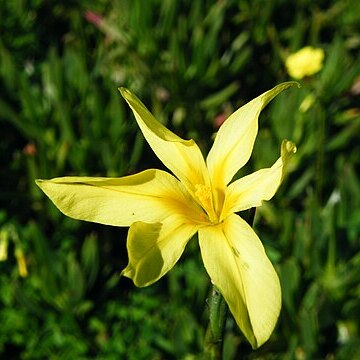Plants 180-350 mm high. Corm 12-18 mm diam.; tunics of wiry, black fibres. Stem abruptly flexed outward above sheath of foliage leaf, simple or few-branched, branches also flexed outward, bearing attenuate sheathing leaves 20-40 mm long. Foliage leaf solitary, inserted well above ground, channelled, exceeding stem, usually trailing distally, 4-10 mm wide. Rhipidial spathes attenuate, inner 50-80 mm long, outer ± 1/2 as long. Flowers long-lived, pale yellow or salmon-pink, outer tepal limbs usually with deep yellow nectar guides at bases edged green, spreading, claws suberect, forming a narrow cup ± 12 mm deep, including filaments and anthers, ± 10 mm wide at mouth; outer tepals ± obovate, (25-)30-35 x 10-12 mm, claws 12-15 mm long, often papillate near bases, inner tepals 24-30 x 10 mm. Filaments united in a cylindric column 6-7 mm long, lightly pubescent in lower 1/2; anthers 5-6 mm long, slightly diverging above, yellow; pollen yellow. Ovary cylindric, (10-)14-19 mm long, often partly included; style branches (5-)6 mm long, diverging slightly and reaching anther tips, stigma lobe arched over anther tips, crests ± 1 mm long, erect to incurved. Capsules cylindric, (21-)30-40 mm long, short rounded beak ± 1 mm long. Seeds angular.
More
Cormous geophyte, 20-50 cm, stem flexed outward above leaf sheath. Leaf solitary, linear, channelled. Flowers yellow or salmon, tepal claws forming a cup including the stamens, faintly scented.
Pending. See James & Brown (1993: 121), as Homeria collina.

